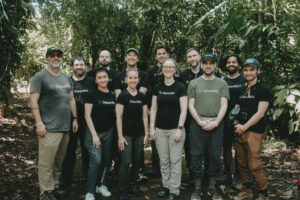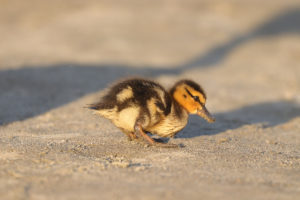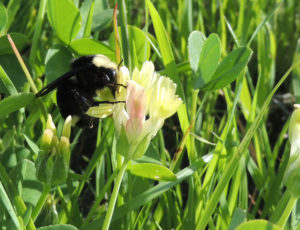Four-year-old Annika Arnout, on a neighborhood outing with her caregiver Targe Lindsay and her pet garden snail Slimy this spring, found not one, but two, colonies of Plebeia emerina, a tiny, stingless bee native to Brazil, adding a new twist to an entomological detective story 70 years in the making. The colonies are nesting in two different trees about a mile from Elizabeth Gamble Garden in Palo Alto, and both already have tube-like defensive openings, which the bees construct out of resin and wax.
“I climbed the tree and I saw the black bugs,” Annika said. “I scratched myself on my hand right here. But it was no big deal. I couldn’t tell if they were bees or wasps.”
The fact that Annika knew that there was a difference didn’t surprise Lindsay, a naturalist, former biology teacher and docent at Stanford University’s Jasper Ridge Biological Preserve who has been feeding her fire for entomology for years. Annika’s mother, Jen Arnout, agreed: “Annika’s very inquisitive and fearless about anything alive,” she said. “She’s an explorer. She picks up ants with her tiny fingers and puts them in her pocket, and they swarm out of her pocket at home. She captures ladybugs and roly-polys, presses flowers, and rescues worms from the sidewalk when it rains.”
Lindsay aspirated a few of the bees from the nest and preserved them in alcohol to show to his son-in-law, an entomologist working in Patagonia. “Targe sucked them up with his bug-sucker,” Annika added, tugging at her pink T-shirt with a beetle printed on it.
This find is special: it is only the third and fourth colonies of this species of bee ever found in Palo Alto. Professional entomologists and citizen scientists have looked, but it took Annika’s sharp eyes to come up with the win. “Kids find so many things that adults overlook,” Lindsay said.

How did these bees get to Palo Alto in the first place?
In 1948, an intact colony of Plebeia emerina, a tiny, stingless bee in the Meliponini family, was shipped by a Brazilian entomologist to his Stanford University colleague via the United States Department of Agriculture. Stingless bees are good pollinators, and Dr. Paulo Nogueira-Neto was interested in their breeding and inbreeding.
“Paulo Nogueira-Neto (1922-2019) was a Brazilian environmentalist. He headed the first federal environmental agency in Brazil, the forerunner of today’s Ministry of the Environment,” wrote Dr. Martin Hauser, a senior insect biosystematist for the California Department of Food and Agriculture’s Plant Pest Diagnostics Branch, in a 2020 presentation to the Pacific Coast Entomological Society.
As an experiment, Nogueira-Neto shipped 30 colonies to the USDA, which were forwarded to university entomologists in different cities in the United States. At the time, the USDA was interested in discovering what bees outside the country might make good agricultural pollinators here, according to Hauser.
Other colonies rapidly perished, but the Plebeia colony maintained by Stanford Professor George Schafer in his Palo Alto backyard survived for eight years, until they disappeared and were presumed dead.
And with that, presumably, the experiment was at an end. Professor Schafer passed away in 1962, and there were no further sightings of Plebeia in Palo Alto.
“In 1948, I sent 10 colonies of Meliponini to the United States Department of Agriculture, and 20 others in 1950,” wrote Nogueira-Neto in a paper published in 2002. “They were forwarded to Baton Rouge (Louisiana), Tucson (Arizona), Davis and Palo Alto (California), Logan (Utah) and Beltsville (Maryland). A [colony of] Plebeia sp. lived eight years in Palo Alto with Prof. G. Schafer. The other colonies died in less than one year.”
Nogueira-Neto concluded that ecological stress was of “paramount importance” in the lives of stingless bees, and likely limited their expansion. However, in the same 2002 paper, he allowed that in some cases, “There may also be a kind of ecological compensation in places where very favorable local ecological factors would compensate for other ecological factors that are not so well suited for these bees.”
Little did he know how right he would be.
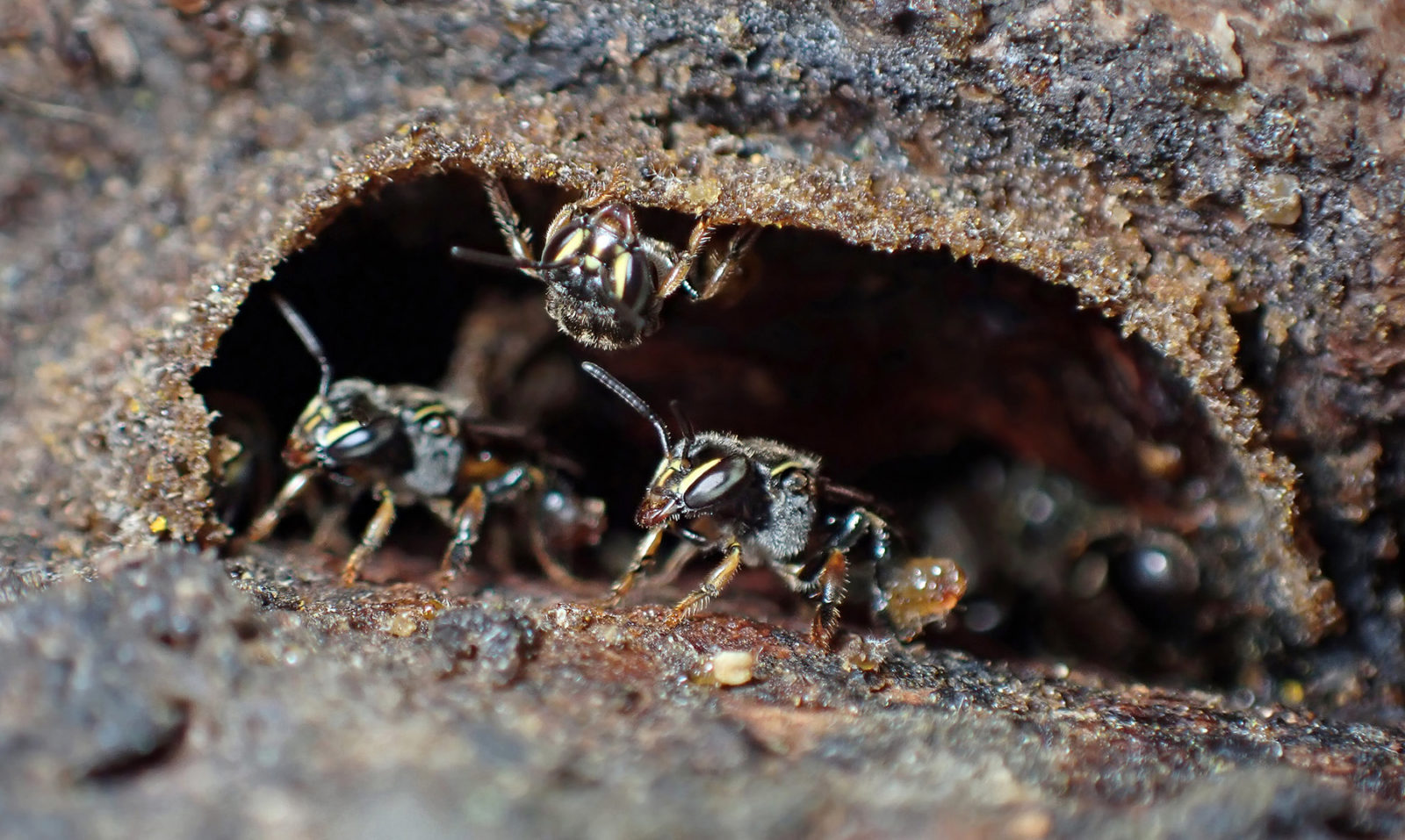
The Re-Discovery and the Detective Work
On September 6, 2013, after 65 under-the-radar years, a homeowner found a colony of small, stingless bees in a backyard tree in Palo Alto, very near Professor Schafer’s house. The shady, well-irrigated yards of suburban Palo Alto had proven to be the sufficient ecological compensation Nogueira-Neto predicted.
“A customer of mine called regarding these strange ‘wasps’ she was seeing in her tree,” said Richard Schmidt, part owner and vice president of Killroy Pest Control. “She said they were active in a knot hole about 3.5-4 feet high up the trunk. Initially I went by to investigate but didn’t see any activity at all. I reported the same to my customer and drove away. About 10-15 minutes later she called me and said ‘Come back, they are there again!!’ So I turned around and found these unfamiliar looking insects scurrying around the trunk at a fairly active speed. I was able to capture a couple, and I delivered them to the Santa Clara County Division of Agriculture and requested an identification from the biologist. He had not seen them either, and didn’t know what they were. He sent them to CDFA in Sacramento.”
“When the exterminator sent them to me, I thought he was playing a joke,” said Hauser. Schmidt included the following message with his specimens: “Please ID wasp. Any threat to kids, pets? Predatory? Hundreds flying around hole in ash tree trunk. Thanks.”
Hauser was dispatched to Palo Alto to take a look. He convinced the homeowners not to exterminate the bees immediately, and in fact, they still recall these events and their unique bees fondly. “The now-deserted nest was in an extremely shady location in a very old and large tree, as well as under a mock orange tree that grows beneath it,” they said (they asked to remain unnamed to preserve privacy). “The stingless bees were there for a number of years until the tree hole closed up.” The tree died in 2019 and fell down in January 2020, but they saved a large chunk of the nest for Hauser to examine.
“The USDA guys thought that maybe the bees had been transported here stuck on the undercarriage of a truck coming up from Mexico,” said the homeowners.
Hauser identified the bees as genus Plebeia, and sent samples to Gabriel A. R. Melo of the Zoology Department of the Universidade Federal do Parana in Brazil, who subsequently identified the species as Plebeia emerina. It was a Brazilian species, not a Mexican one, but how the bees arrived in Palo Alto, thousands of miles north of their native range, remained a bizarre unsolved entomological mystery for another five years.

In 2018, a second colony in the same neighborhood in Palo Alto was discovered at Elizabeth Gamble Garden by its garden director, Richard Hayden. “I used the tree trimmer’s bucket truck to take the first photos and later to collect the specimens,” he recalled in an email in 2020. The public garden, with its high year-round diversity of flower food sources, remains one of the best places to spot foraging bees, including Plebeia emerina, in Palo Alto.
“Richard was always interested in my efforts to photograph and catalog the diversity of native bees in the Gamble Garden,” said Palo Alto naturalist Selwyn Quan. “When he discovered the Plebeia colony at the Gamble Garden, he introduced me to Hauser, whom he had asked for help with the identification. Richard showed Martin some of my bee photographs taken in the garden to confirm the Plebeia ID.”
Quan also posted his observation of these bees to iNaturalist. It surprised bee expert Dr. John Ascher, who wrote, “Should not be in the USA! Unknown in the wild N of Mexico!”
Quan’s iNaturalist observation also caught the attention of Dr. Arian Avalos, a research geneticist with the USDA’s Agricultural Research Service in Baton Rouge, Louisiana, who made the incredible connection between the presence of these bees in Palo Alto and Noguiera-Neto’s 2002 paper.
Avalos said, “I had been independently reading Dr. Noguiera-Neto’s work on social stingless bees when I joined the Honey Bee Breeding, Genetics, and Physiology Research Laboratory in Baton Rouge, Louisiana, out of personal interest in this group of organisms and because the laboratory had an archived copy of his work which I had not had an opportunity to read before. In the book, he had mentioned the collaboration to examine the feasibility of stingless bee management (meliponiculture) in the US. I then was curious about whether any reports had been made of the genera described in the book, since the effort was quite intensive and it was surprising no reports of this group of bees had surfaced before. After some sleuthing across several citizen science listings, I found [Quan’s] observation on iNaturalist.”
“Avalos connected the dots,” said Hauser. “It shows how many people and how many strange coincidences are needed to solve a puzzle like this.”
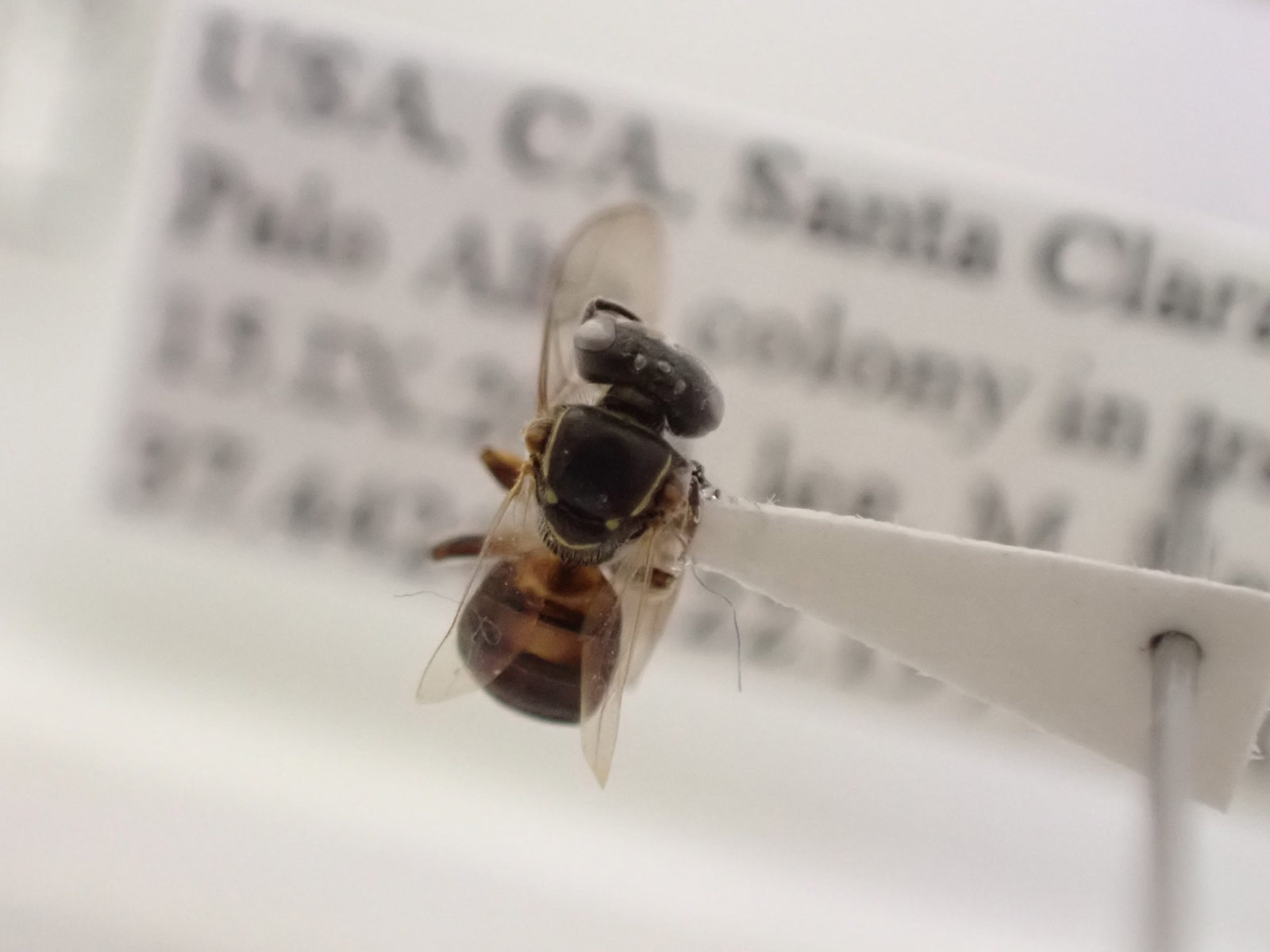
Are They Invasive?
Almost immediately, there was concern from the USDA that the non-native Plebeia would pose a danger to commercially important western honey bees (Apis mellifera), another non-native species well established in California. Hauser sent specimens from this colony to stingless bee entomologists in Brazil, and after some months of research, both in Sacramento and Brazil, was able to identify them as Plebeia emerina. He also was able to use his powers of persuasion to stay the execution of the bees, pointing out that honey bees are thriving in Brazil despite their close proximity to Plebeia and many other Meliponini species. Basically, his argument was that this small population of bees in Palo Alto was simply going about their business, pollinating local gardens, and did not otherwise impact the environment.
“While it is sometimes even difficult to distinguish between native and non-native, we usually call species which ‘negatively alters its new environment’ as invasive,” said Hauser. “So yes, we can call the bees non-native, but not invasive, because they did not negatively impact the local fauna. The local fauna has already been destroyed because of the urban environment. But honestly, this is just the human perspective. Judgments like good and evil, positive or negative, are not intrinsic, but depend on the perspective. If your cat throws up on your floor, it is bad for you, good for the cat, and perfect for the flies which feed on it.”
According to Hauser, Plebeia emerina is one of 512 species of stingless bees in the world. They are quite small, about 5-7 millimeters, and with their shiny black bodies and snazzy yellow trim on head and thorax, it is understandable that many people mistake them for wasps or gnats. They nest in mature trees, in narrow cracks and holes which they augment with a camouflaged entrance tube made of resin and wax. They have been spotted on a fairly diverse menu of native and non-native flowers according to the season: foxglove, California poppy, California fuschia, showy milkweed, bulbine, geranium, viburnum, daylily and Hebe. “Because they are non specialized pollinators, they can utilize a large variety of native and non-native plants,” Hauser said.
Looking at the dates of observations, it also appears that the Palo Alto population of Plebeia forages nearly year-round, perhaps because of the availability of these suburban flowers.

Crowdsourcing the Hunt for Stingless Bees
Since their remarkable re-discovery, Hauser has continued tracking the Palo Alto Plebeia emerina and monitoring for signs of additional colonies. “Their slow spread is really interesting: they are hanging on for 70 winters and fire seasons, droughts etc, but not spreading significantly,” Hauser said. “The city has more flower resources year round, but another factor might be that the new colonies are founded by the old colony splitting and a new queen flying off with a large amount of the workers into a new nest. I suspect that these swarms might not fly very long distances; the much-bigger honey bee swarms usually fly less than one kilometer.”
“Martin was curious about how widespread Plebeia emerina was in Palo Alto, but since he was based in Sacramento, he could not easily look for additional Plebeia emerina colonies in Palo Alto,” Quan said. “He asked if I was interested in helping him look around the area to get a sense of how widespread Plebeia was in the local community. That summer, I spent some time in the local parks and community gardens looking for Plebeia with my seven-year-old son, Kyle, who found our first Plebeia in a California poppy at the community garden in Eleanor Pardee Park about a mile north of the Gamble Garden. I found another in the Edith Johnson Community Garden about a mile west.”
Quan established the Bay Area Plebeia Watch project on iNaturalist to help Hauser crowdsource the search for Plebeia in Palo Alto and further afield, to see if they have spread beyond the neighborhood during those 65 mystery years. After more than 100 photo-documented observations by several local photographers, so far no Plebeia emerina have been spotted outside the Palo Alto city limits.
“It is obvious from this example that having a greater set of eyes looking can lead to some interesting findings,” Avalos said.
“There are some scientific questions that are partially answered,” Quan said. “Dr. Paulo Nogueira-Neto’s 2002 question regarding inbreeding and building up small populations of stingless bees is shown to be possible, as demonstrated by this Palo Alto colony. The Palo Alto population offers some interesting opportunities to compare two independent populations after decades of separation. By comparing the genomes of the original population versus the Palo Alto population, we could see evolution in action and investigate what has changed after so many generations.”

“It is remarkable that 70 years after the introduction of this species, it was not found for decades, and that a little girl, who had an interest in bugs and a different, unique perspective, suddenly found more colonies,” Hauser said. “This also highlights citizen science at its best, because none of the established bee/pollination researchers would collect in some ‘posh’ neighborhood of a city, or a city at all. Urban entomology exists, but they often study the insects in houses. It has always been the thinking that good bee diversity and the rare and interesting bees are in pristine environments, and that what we have in cities is just a more boring assemblage of the most common and undemanding species from surrounding areas.”
“So little research has been done,” he added. “But this has changed with websites like BugGuide and iNaturalist. Citizen scientists have been focusing on what is living within a certain area of interest, such as their own backyards. They are not as taxon-driven as the professional scientists, and they spent a large amount of time observing their local patch. They come up with observations which many scientists would not have the time to do.”
Correction: This story has been corrected and updated to show that the species-level identification of the Palo Alto bees was made by Gabriel A. R. Melo of the Zoology Department of the Universidade Federal do Parana in Brazil.


